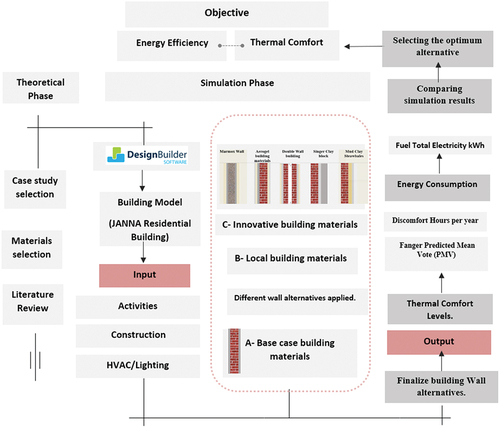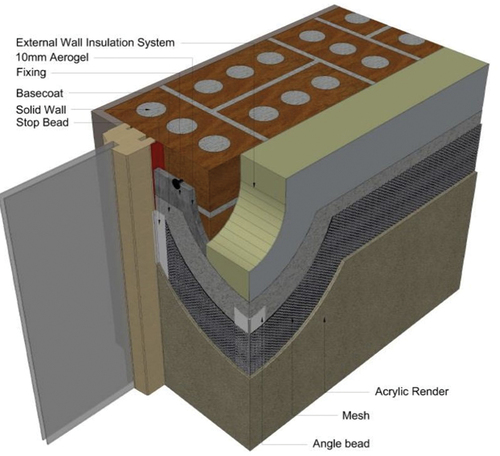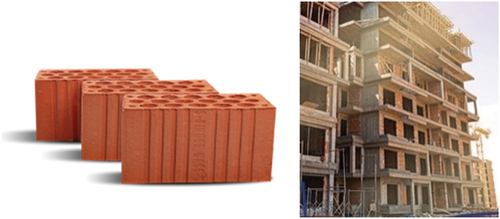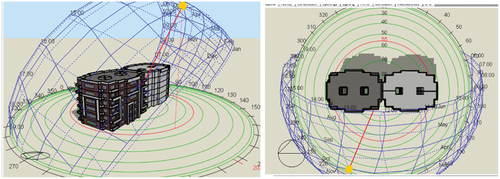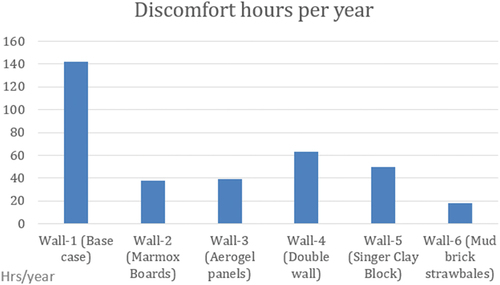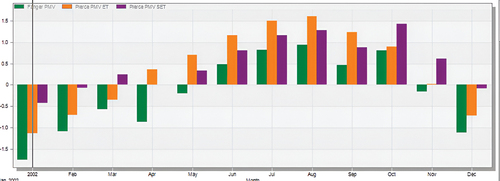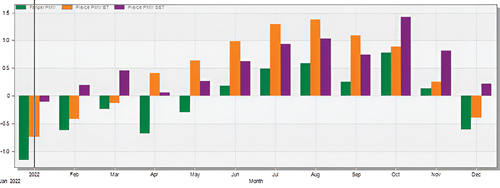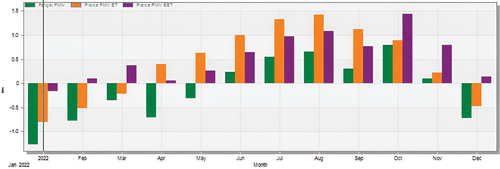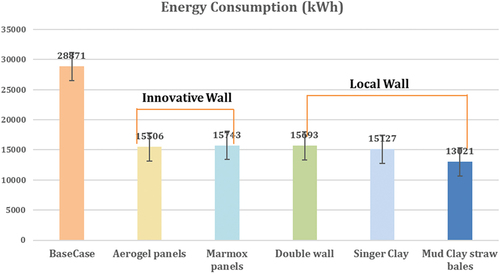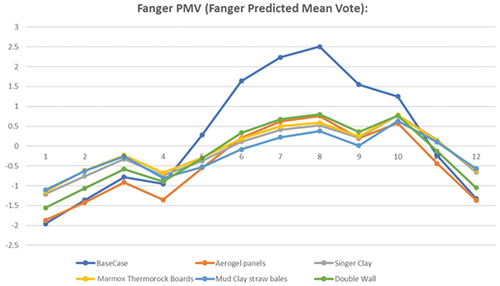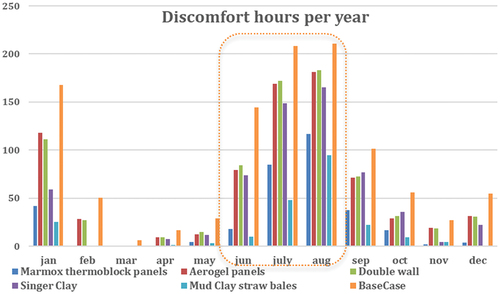ABSTRACT
Nowadays, the majority of nations are facing the challenge of global warming which has caused less thermal comfort in indoor environments with further energy consumption. To mitigate these negative impacts, selecting appropriate building materials with environmental design principles is crucial to meet user’s needs. This study aims to investigate the impact of implementing innovative and locally sourced building materials in the wall construction of a residential building in Egypt; to improve energy consumption and users’ thermal comfort. The thermal performance of six alternative walls was analyzed and compared using computer simulation software. Alternative wall systems included innovative materials, such as Marmox boards and aerogel panels, as well as local materials such as double wall, Singer clay blocks, and Mudbrick with strawbale. The simulation results demonstrated that the Mudbrick strawbale exhibited the best thermal performance among all alternatives. It reduced energy consumption by 45% and decreased discomfort hours to an average of 18 hours per year. The innovative materials, Marmox board, and Aerogel panel, also showed promising results that were comparable to those of Mudbrick strawbale. This confirms that local materials can offer superior thermal performance when used in appropriate wall techniques. The overall study results revealed that implementing alternative wall strategies using environmentally sustainable building materials in residential settings can lead to energy savings ranging from 29% to 45%, as well as a reduction in annual discomfort hours by over 50%. This study highlights the effectiveness of using alternative wall strategies as a solution for addressing environmental adaptation gaps in residential settings.
Introduction
Recently, the phenomenon of global warming and consequent temperature rise has resulted in a thermal comfort reduction, increased usage of cooling systems during hot seasons, and a surge in energy consumption. This, in turn, has caused a rise in pollution from power plant activities, thereby creating a vicious cycle that causes irreparable damage to natural resources and sustainable environmental conditions [Citation1]. The buildings sector is a major contributor to this problem, accounting for 30% of energy consumption and around 27% of global emissions in 2021, where residential buildings alone consume more than one-third of worldwide electricity usage [Citation2].
Between 2008 and 2017, the residential sector in Egypt experienced a notable surge in electricity consumption, accounting for 42.9% of the total consumption. However, as shown in , it is noteworthy that there has been a decline in residential consumption since 2018 due to the adoption of LED lamps for lighting purposes and multimedia awareness campaigns [Citation3]. Yet, after a 1% reduction in 2020, the usage rose by 6% the following year [Citation4]. In August 2022 the Government revealed in a statement that electric consumption has risen to the highest load in Egypt’s history during the peak hour recording 34x.2 thousand megawatts [Citation5]; this is attributed to two things: the growth of new communities and residential compounds, as well as the use of household appliances, particularly air conditioners, during hot periods.
Figure 1. Egypt Total energy consumption chart [Citation3].
![Figure 1. Egypt Total energy consumption chart [Citation3].](/cms/asset/02bfc1ef-ae0c-44b7-996f-0d2f141e7f49/thbr_a_2268290_f0001_oc.jpg)
Giovoni claimed that; Since the indoor thermal atmosphere and the need for ‘heating or cooling’ are determined by the thermal properties of materials, then the thermal behavior of the wall materials has a significant effect on the tenant’s comfort levels, regardless of the mechanical control system usage [Citation6]. Hence, the lack of insulation properties in the envelope of the buildings is synced with the rise in energy consumption and thermal comfort reduction. This issue can be alleviated by selecting the proper construction wall materials considering the environmental and sustainable design standards, which would significantly enhance thermal and lessen the harmful effects of construction [Citation7].
Generally, There is a variety of insulating bricks available for commercial use in each region, Some of these bricks are produced locally using materials found in the surrounding environment, which can be composed of filling materials, such as air, natural mineral wool, strawbales, mud, clay, or bamboo fiber, etc. These materials are classified as local materials and are known for their thermal performance [Citation8], On the other hand, there are also new materials that incorporate innovative technologies and features in different ways. Examples of these materials include Expanded Polystyrene (EPS), Rockwool, smart concrete, Aerogel Panels, and Thermo rock boards. Although these innovative wall materials may have higher initial costs, they possess exceptional thermal properties [Citation9]. outlines several factors that can help distinguish between local and innovative materials in buildings’ external walls.
Table 1. Distinguishing between local and innovative building materials.
The interaction between these building materials, design elements, weather, tenants, ventilation, and other systems is complicated, By employing energy simulation models, all the influencing factors in the process can be considered and analyzed [Citation10]. Engineers must estimate energy consumption early in the design process to avoid major design flaws. Energy simulation software, based on climate situations and other influential aspects, assists designers in making precise predictions of building performance and environmental assessments of buildings in cities [Citation11].
Thus, the main objective of the study is to investigate different types and techniques of building wall materials in an attempt to enhance the relationship between energy efficiency in the residential sector and environmental sustainability by improving thermal comfort levels. Accordingly, the research compares the thermal performance of proposed local and innovative/new building materials strategies instead of the conventional one. The study applies these wall-building materials at the south façade of a residential dwelling as a base case and then estimates, using energy simulation software, the thermal comfort and energy usage throughout the year of each wall type; to achieve more sustainable and energy-efficient residential buildings in Egypt.
Research methodology
To attain the main goal of the study, various procedures were implemented. Initially, a theoretical review was conducted to investigate commonly used environmentally friendly wall materials whether innovative or locally sourced. Following this, a residential case study was selected in Egypt and the required data was collected. The energy usage and thermal comfort level of the case study were then tested using Design Builder Simulation V7 [Citation12]; to explore ideas on how to improve the energy efficiency of the residential unit by incorporating local and innovative building materials commonly used in Egypt. illustrates the six wall alternative techniques considered in this study, including local materials such as brick walls, Singer Clay Blocks, Double Walls, and Mud Brick Strawbales, as well as innovative building materials like Aerogel panels and Marmox thermo-rock panels. The simulation results were compared to determine the most effective wall technique regarding thermal comfort and energy efficiency within this specific region.
Literature review
Designing a building in developing countries can be challenging when estimating thermal insulation and thermal comfort; as a result of the diverse types of buildings designed for various purposes. A study by Al Tamimi (2020), revealed that in buildings with inadequate insulation, their exterior walls are accountable for approximately losing 33% of heat [Citation13]. Therefore the exterior wall is crucial in any building as it regulates the transfer of heat from direct or indirect sources and impacts human thermal comfort and their quality of life [Citation14]. Thermal comfort was defined by the ASHRAE standard; as the psychological state attained when a person is content with the thermal atmosphere [Citation15], According to Givoni (1998) and the notion of Adaptive Comfort, the investigations have employed the 20°C–29°C as a thermal comfort range [Citation16]. While the initial comfort range, which was listed in EREC (HBRC 2008), was 22.2°C to 25.6°C [Citation17]. Currently, Various methods are available for assessing the thermal comfort metrics in a building, One such method is the predicted mean vote (PMV), to evaluate the users’ comfort considering six variables. The PMV is a measure of how people feel based on their self-reported feelings on a scale from −3.0 to + 3.0 [Citation18,Citation19]. Another method for identifying thermal comfort was by calculating the number of discomfort hours caused by over-or under-heating and cooling, as well as unhealthy relative humidity, with respect to occupied hours [Citation20].
Bricks and blocks have been an important construction material for over a century due to their high compression and extended durability features, Previous studies have provided valuable empirical references regarding the identification of wall materials and their impact on the building thermal performance in different regions. Joseph (2015) investigated the thermal characteristics and durability of ‘aerated, fibo, and silbet blocks’ with lightweight building blocks, The study also explored the use of expanded thermistors and glass wool to improve thermal performance [Citation21]. Ahmad (2017) examined the addition of local materials ‘Clay and wheat husk’ to bricks, his investigations included thermal performance, water absorption, and other properties of clay bricks, the study recommended incorporating 15% of waste to brick [Citation22]. Walker, (2018) explored the integration of cell pores into fibers such as ‘bamboo, cotton stalk, and sand’ to improve wall materials’ thermal performance [Citation23]. Vijayan (2021) Conducted a review study on various sorts of bricks including ‘Stone Masonry, burnt clay bricks, solid sand lime blocks, cement hollow blocks, thermos acoustic blocks.etc’., The study concluded that mudbrick effectively reduces heat loss. Moreover, advancements in technology have significantly improved the use of insulator materials [Citation24]. Diano and Ramos, (2020) emphasized identifying reducing energy consumption can be accomplished with the smart design of insulating wall materials techniques. The study advised carefully selecting the materials employed to regulate heat flow in a space, taking into account the environment, implementation techniques, and convenient operation [Citation25].
Further studies relied in their investigations on comparing alternative multi-layered materials walls as the one conducted in Tehran, by Mohammad, (2013), where he compared the thermal efficiency of contemporary wall structures to the conventional unfired clay and brick materials utilized in local residential buildings, to determine the optimum replacement regarding energy efficiency. The research suggested ‘hollow clay, autoclaved aerated concrete, or light expanded clay blocks’ and at last recommended the Leca Block as a more sustainable wall building than the AAC block [Citation26].
Scholars in Sri Lanka as Udawattha et al. (2019) explored the thermal and cooling performance of 3 commonly used wall materials by site measurements in addition to computer simulations, the study conducted three different wall thicknesses of ‘brick, cement block, and concrete mud’ to discover which thickness materials were best for Sri Lanka’s climate. The mud concrete block was the optimum choice for wall construction due to better cooling and thermal performance compared to other materials [Citation27], While Kisilewicz, (2019) illustrated a study that compared variations without thermal insulation and another with an insulation layer, the study found that the overheating duration using a thermal insulation layer (10 cm) increased by 12% to 15%, compared to without insulation. while the overheating period is prolonged by 4% to 9% when thermal insulation is thickened to 30 cm [Citation28]. Wernery, (2017) discussed reducing the thermal conductivity of an insulating brick by replacing the perlite filler with a unique highly insulating aerogel material (Aero brick or An aerogel-filled insulating brick), The results showed that thermal conduction decreased from 91 down to 59 W/m·K for these ‘Aerobricks’. Therefore, with aerogel fillings, the insulating brick thickness can be reduced, resulting in space saving and users’ thermal comfort [Citation29]. Another innovative material that has gained little research is the Marmox board applications in wall facades. Murtadha et al. (2017) conducted a study for a room in Baghdad city with implemented solar chimneys in the solar façade, Marmox was used as an insulation wall in the outer walls while the roof and floor were insulated by Marmox thermo-block [Citation30]. Similarly, Kytömäki (2017) applied Marmox boards under wall facades to prevent cold bridges from happening and reduce heat transfer through walls, and floors, for more energy efficiency and lower heating costs [Citation31].
In summary, this literature review highlights the significance of selecting appropriate wall materials for optimal building thermal performance. They discussed different types of bricks and blocks, as well as innovative material approaches to improve building efficiency. However, there is a lack of comparative research analysis on the performance and applicability of various materials, especially in hot developed countries.
Proposed alternative materials for wall façades
In Egypt, commercially available insulating brick wall construction comes in a variety of forms and has a low thermal conduction range of 70–90 mW/(mK) when filled with ‘air, wool, EPS, or perlite’. Nowadays, the commonly used traditional wall materials in Egyptian residential neighborhoods, are burnt hollow clay brick, as well as cement brick. There are other available less-used local materials such as mud brick and straw bales. Recently, new innovative wall materials are being employed as Marmox Boards, and Aerogel insulation due to their beneficial thermal properties. This research aims to provide insights into the thermal performance of different wall techniques using the following materials.
Marmox boards (light structural panels)
Marmox Thermo-rock is considered an innovative, user-friendly material, a fire-resistant extruded load-bearing board made of rock wool connected with a rigid frame and fiberglass mesh on both sides and polymeric cement that is often positioned at the outside wall as shown in . Marmox offers a group of light structural panels characterized by moisture, heat, sound insulation properties, and shocks, with a thermal resistance of 1.43 m2 K/W. It can be installed on all sectors and different surfaces including facades, The panels were made in an innovative way to accept all types of finishes, The average board thickness is 12 mm and can reach 100 mm, and the single board weighs 4–15 kg. The average cost of these boards starts at 30 dollars per square meter and varies by their thickness [Citation32]. Marmox has many external use applications such as insulation of buildings from heat to save energy, Covering the walls and ceilings of metal and wooden structures, decorative and architectural formations, renovation and restoration of facilities, and Truss roofs for factories and farms as shown in [Citation33].
Figure 3. Marmox board multi-layers [Citation31].
![Figure 3. Marmox board multi-layers [Citation31].](/cms/asset/5eaa20f4-7198-4195-8aed-833bae56ab44/thbr_a_2268290_f0003_oc.jpg)
Aerogel panels
Aerogel is composed of a porous structure with nanoscale particles, creating a material that is extremely lightweight and highly insulating. Its low thermal conductivity allows it to effectively minimize heat transfer, making it an ideal choice for insulation in the building sector [Citation34]. Aerogel-based materials are widely used as insulating sheets of various thicknesses ranging from 10,19 to 59 mm, or plaster and tiles on building walls as depicted in . Moreover, aerogel is transparent, allowing for the passage of light while still providing insulation. This makes it suitable for applications such as windows and skylights. Aerogel is simple to use, recyclable, durable, versatile, and reusable materials. The average price of aerogel is 50 dollars per square meter for the 10 mm thickness. Many researchers are developing aerogels with low environmental and economic costs as an alternative to existing building insulation materials due to their low thermal conductions (14–19 mW/(m. K)), high hydrophobicity, and adequate fire resistance [Citation35].
Singer clay blocks
A Perforated Brick Block with holes of a ratio of 35%, as shown in , burnt at 900 degrees Celsius. According to Singer Factory in Egypt, the block dimensions are (25 × 12 * 13) cm, and around 250 blocks are adequate to build a 1 cubic meter wall, The Singer block is faster in construction, less mortar and cement used, and has better insulation than the conventional clay blocks, with 0.55 M2.K°/W. It allows flexible design, fire resistance, and low water absorption. Building work is environmentally friendly and requires little maintenance with a long life span of more than 100 years [Citation36]. Hence, they maintain a comfortable indoor atmosphere by controlling the temperatures and air humidity inside the space [Citation37]. Singer bricks are quite affordable as they cost an average of 20 dollars per 1 cubic meter.
Mud Brick and Strawbales
In Egypt, there are tons of rice straw left over every year. Burning it can cause a lot of air pollution and health issues [Citation38]. It has been extensively studied and researched in Egypt to discuss its potential to be used in the brick wall sector as an economical and sustainable building material. The cost of materials for a brick wall made of straw would be around 2.5 dollars, whereas the cost of a brick wall would be around 18 dollars per cubic meter [Citation39]. In order to create new composite straw-cement blocks that are affordable and excellent insulators, they may also be recycled by mixing them with cement [Citation40]. The study applied straw bale as an insulation layer next to the mud brick in the wall construction this technique results in a larger wall thickness that may affect the indoor space function.
Empirical study
Model definition: Janna Compound, New Cairo campus, Egypt
‘Janna Compound’ is a housing project built by the Egyptian Government to meet the rising demand for residential units, The project has been repeatedly built in various cities in Egypt as El-Sheikh Zayed, Al-Minya, and New Cairo … etc., regardless of the local climate, or the cost of materials. Residential units are situated across the entire site by repeating the same models (types A, B) with varying directives based on the land’s site form, and urban design.
The selected site was the one located in New Cairo as shown in . The primary factors in the selection of this project were: the typology of the project as a highly-demand residential project; due to payment facilities provided by the government, high resident counts, as well as, the climatic status of the New Cairo context, the lack of thermal comfort in many units according to residents; as many of them tend to use air conditioners in the summer and heating devices in winter, the increased energy consumption, beside the fact that the project is inhabited assisted in the availability of collected data, unlike under-construction project sites.
Figure 7. a) on the left: the location of Janna New Cairo Compound Campus, Cairo, Egypt [Citation41], b) on the right: view of case study building, author.
![Figure 7. a) on the left: the location of Janna New Cairo Compound Campus, Cairo, Egypt [Citation41], b) on the right: view of case study building, author.](/cms/asset/e575bf7a-171e-447a-9708-843e78724ca9/thbr_a_2268290_f0007_oc.jpg)
The case study model is type A, highlighted in , and includes a ground floor and five recurring floors, each with four residential flats of approximately 130 square meters [Citation42]. On average, each flat accommodates four occupants. The south façade of this building was adapted to different materials in the simulation; as it is the most heat-exposed façade and has an unfavorable orientation according to the sun path of the site; to improve overall environmental building performance.
Climatic outlines: Cairo, Egypt
According to the international weather for energy calculation data file, Cairo has previously been applied in the Energy Plus Design-Builder simulation. Using the weather and solar tools [Citation43], Climatic data for the site revealed that higher summer temperatures reach 35–45 °C in August, while lower winter temperatures range 15–20 °C, as shown in .
Figure 8. Egypt climate graph [Citation34].
![Figure 8. Egypt climate graph [Citation34].](/cms/asset/00a5ec5f-03df-452f-9605-cd7c7075c248/thbr_a_2268290_f0008_oc.jpg)
Building simulation
The simulation was performed using the graphical user interface V7 of Design Builder, which incorporates Energy Plus calculation engines. The design-builder was chosen for its flexible geometry input, extensive material library, and load profile. In addition, it includes control procedures to ensure results accuracy compared to independent Energy Plus engines. Simulations in the Design-Builder program included modeling the consumption of cooling and heating to evaluate the building’s performance as illustrated in . Local and innovative layers have been applied to increase energy efficiency and improve the user’s comfort in the space. The specifications for the original wall-building materials used in the simulation are given in .
Figure 9. On the left building layout, and the right is typical floor plan, Janna project New Cairo site, model building type A, author.
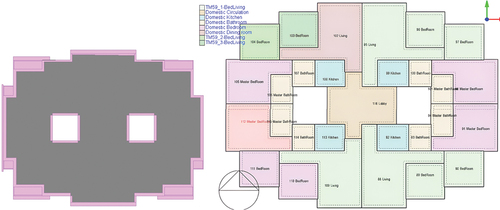
Figure 11. a) front elevation (south façade), b) side elevation for the residential building. Author.
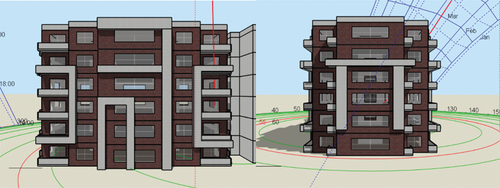
Table 2. Construction layers of the base case.
Building materials specifications
Previous research has shown that incorporating a multilayered wall construction with varying thermal characteristics can improve the wall’s thermal performance. In this study, five alternative building wall materials were selected and applied to a building in the ‘Janna residence project’, as a base case model, to investigate their thermal performance. The model was developed, and the south façade opaque wall was adapted using multiple layers of materials with different techniques, considering factors such as material properties, thickness, and dimensions provided by the manufacturer. The commonly used ‘Burnt clay hollow brick’, was utilized in walls 3 and 4 as it was readily available in the local market and already used in the base case [Citation44]. To ensure consistency throughout the study, both the outer and inner finishing surfaces were standardized across all alternatives. displays the input parameters for the base case example (wall 1). All input parameters are initially fed into the base case to assess its performance before applying the recommendations for each wall technique.
Table 3. Input parameters of design Builder simulation of the residential building case study.
Alternative materials for south wall facade construction input
Wall-1: Traditional Brick wall, (Burnt Clay hollow Brick).
Wall-2: Marmox Thermo-Rock layers.
Wall-3: Double walls separated by an air gap.
Wall-4: Aerogel panels and brickwork.
Wall-5: Singer Clay Block.
Wall-6: Mud Brick and strawbales. below shows the allternatives onstruction materials input.
Table 4. Construction materials input.
Data Analysis Results
Annual energy consumption
Overall, the energy consumption of the base case wall material increased during the summer specifically the ‘May, June, July, and August’ months; due to the increased solar irradiance. However, according to the simulation results, the total electricity measured in August was reduced by an average of 45%, 32%, and 29 % for the local materials proposal in the case of walls 4, 5, and 6 respectively, while the innovative materials saved approximately 29% to 30 % as measured in wall 2 and 3. illustrates that the base case wall achieved 30,485,67 kWh in August, while the innovative building materials as the Marmox Thermo Rock panel adaptation achieved 23,142.71 kWh. compared to Aerogel’s innovative materials that attained 23,059.88 kWh. On the other hand, local building materials such as singer clay block recorded 24,140.55 kWh and mud brick strawbales 21,827.78 kWh. These results support the implementation of local Mud Brick and straw bale as the optimum technique, followed by Aerogel and Mamox thermos rock techniques in terms of energy consumption.
Thermal comfort results
The simulation calculations are based on the number of discomfort hours due to over or under-cooling, as well as unhealthy relative humidity, in accordance with ASHRAE 55–2004. As depicted in , the Simulation results indicated remarkable development in the thermal comfort level bars, where the traditional wall of the base case model indicated an average of approximately 142 discomfort hours per year. On the other hand, the application of Marmox Thermorock panels in wall 2 resulted in a decrease to 38 discomfort hours annually, these results are close to aerogel panels results which were 39 discomfort hours per year. The implementation of a double wall estimated 63 discomfort hours per year, while the Singer Clay Brick wall recorded an average of 50 hours. Conversely, the Mudbrick strawbale wall was only 18 hours on average per year. Thus, it can be inferred that Mud Brick straw bales, as a locally sourced building material option, offer the most favorable outcome regarding comfort hours.
Fanger Predicted Mean Vote (PMV)
The most commonly employed approach to evaluate human thermal comfort in a built environment is through the Predicted Mean Vote (PMV) indices, which are measured on a scale of -3.0 to + 3.0, where −3 is cold and + 3 is hot [Citation45]. A predicted average vote of -0.5 to 0.5 lies in ASHRAE standard 55 Comfort Zone [Citation46,Citation47] while the Egyptian code approves an average of -1.0 to 1.0. Walls 2,3 and 6 were analyzed as well as the base case wall, based on the results of energy consumption and discomfort hours. shows that the Pmv range results of the base case wall (−1.8 to 1.7), do not fall within the comfort range. However, demonstrate that the projected mean average outcomes for walls 2, 3, and 6 fall within the range of (−1.1 to 0.7). This analysis confirms that these alternative wall techniques comply with the accepted comfort range and demonstrate an overall enhancement.
Conclusion and discussion
This study aimed at the optimization of energy consumption and user thermal comfort, in a residential building in Egypt, by evaluating the impact of implementing different building materials in the south-wall façade, Six construction wall material models were simulated using Design Builder, a comparative analysis between Local and innovative building materials outcomes to identify the case with the optimum performance. The comparative analysis results, As shown in , indicates that all alternative wall techniques reduced the energy consumption compared to the base case, with original construction materials, which attained the highest value of energy with 28,871 kWh. Among the alternative wall materials, Mud Clay straw bales had the best performance with an annual energy consumption of 13,021 kWh. Singer Clay and double wall recorded 15,127 KWh and 15,693 KWh respectively. In terms of the innovative building materials, Marmox and Aerogel panels achieved 15,506 KWh and 15,743 KWh respectively, This indicates that Marmox walls have nearly similar thermal properties to implementing Aerogel insulation Panels with ordinary brick walls.
Regarding thermal comfort which depends on the PMV, illustrates the PMV results of the building construction wall alternatives during the summer and winter months, All alternative walls were within the comfort range (−1 to + 1) unlike the base case results, and the comparison between traditional and innovative building materials, showed that the greatest optimization was Marmox thermos rock boards, Mud Clay Strawbales walls, and Aerogel brick wall respectively. Overall, the PMV was improved over the year, which indicates that user’s comfort was attained and this will significantly increase energy efficiency.
while for the thermal comfort related to the number of discomfort hours, as shown in , the base case had the maximum number of discomfort hours, recorded in January, June, July, and August months. The model with Marmox thermos rock panels, Aerogel panels, Double wall, Singer Clay, and finally Mud Clay straw bales had 141, 149,183,165, and 94 overheating hours respectively in August, compared to the base case model with 210 overheating hours. This indicated that the Marmox thermo rock panels and Aerogel reached the highest level of thermal comfort with the least discomfort hours as innovative wall materials.
In conclusion, the adaptation of local and innovative building materials has led to a significant alteration in discomfort hours demonstrating an improvement in thermal comfort. The innovative building insulation materials such as aerogel panels decreased energy consumption by approximately 30% when added to the brick wall, while the Marmox thermal rock wall reduced energy consumption by 29%, However, the local materials including the double wall, singer clay block, and mud clay straw bales reduced energy consumption by average 29%, 32%, and 45% respectively. In general Mud clay and strawbales had significant thermal performance throughout the study. Simulation results have identified an overall comparative analysis for the five alternative building wall materials techniques which include the average energy saving, the average discomfort hours, and the PMV of each wall, as shown in .
Table 5. Energy consumption for all alternative construction wall materials per Month.
Table 6. Comparative results of the alternative wall cases.
Finally, the study investigated how different external building materials blocks affected the thermal efficiency of the south façade of residential buildings. The study indicated that the integration of proposed building materials into the wall construction can improve users’ ‘thermal comfort’ and lessen their ‘energy consumption’ thus increasing the building’s thermal performance, The simulation results of the base case prototype building, referred to a significant amount of thermal transfer from the external walls of a conventional bricks wall to the interior spaces, while the proposed materials improved its energy efficiency from 29% to 45%, and reduced discomfort hours to only 18 hours average per year, in case of employing Mud clay Straw bale wall. While the study verified that the Marmox board has thermal properties similar to adding aerogel as an insulation layer, Mud clay strawbales provided better performance with more availability and economical benefits. These findings are particularly relevant for developing countries with limited financial resources that should be given due consideration.
Recommendations
Overall, the study highlighted the importance of selecting appropriate building wall materials to decrease energy consumption and increase resident’s comfort in their units. The study suggested that Mud Clay straw bales brick wall is a promising option for achieving significant energy savings in hot climates. However, more investigations are needed to explore their durability long-term performance, and feasibility. Moreover, the following recommendations were obtained:
Priority should be given to integrating energy efficiency considerations and measures into the design process of residential buildings.
When choosing envelope materials, thermal insulation building wall materials should be considered to maximize building thermal performance and minimize energy use, thereby reducing operational costs.
Distinguishing between local and innovative materials in buildings’ external walls selection involves considering factors such as sourcing, affordability, availability, sustainability, cultural context, performance characteristics, and cost considerations.
Countries with low-middle income in hot arid climates need to integrate sustainable and cost-effective construction energy strategies that are suitable and affordable within the local context.
This study only focuses on the solid parts of the external walls. Further research can address the materials used for openings and transparent parts of the façade.
Future research is needed to explore cost factors and their impact on overall feasibility and material life cycle.
By considering both thermal performance and cost factors, future studies can provide a more comprehensive understanding of the overall benefits and limitations of different wall techniques.
Disclosure statement
No potential conflict of interest was reported by the author(s).
References
- Umbark MA, Alghoul SK, Dekam EI. Energy consumption in residential buildings: comparison between three different building styles. Sustain Dev Res. 2020;2(1):1. doi: 10.30560/sdr.v2n1p1
- IEA (2022), Buildings, IEA, Paris License: CC BY 4.0 Available online https://www.iea.org/reports/buildings
- EnerData, Country Energy Report, Egypt (2023). [cited Feb 2023]. https://www.enerdata.net/estore/energy-market/egypt/
- Abdollah MAF, Scoccia R, Filippini G, et al. Cooling energy use reduction in residential buildings in Egypt accounting for global warming effects. Climate. 2021;9(3):45. doi: 10.3390/cli9030045
- Nader N (2022). Egypt electricity production up by 30,000 mw in 6 years: ministry spokesperson. AhramOnline. [cited 2023 May 1], https://english.ahram.org.eg/NewsContent/3/16/473983/Business/Energy/Egypt-electricity-production-up-by-,-MW-in–years-.aspx.
- Givoni BM. Climate and architecture, 2nd ed. London, UK: Applied Science Publishers, 1976:pp. 1–144. ISBN 978-0853346784.
- Fawaier M, Bokor B. Dynamic insulation systems of building envelopes: a review. Energy Build. 2022;270:112268. doi: 10.1016/j.enbuild.2022.112268
- Homod RZ, Almusaed A, Almssad A, et al. Effect of different building envelope materials on thermal comfort and air-conditioning energy savings: a case study in Basra city, Iraq. J Energy Storage. 2021;34:101975. doi: 10.1016/j.est.2020.101975
- Kumar D, Alam M, Memon RA, et al. A critical review for formulation and conceptualization of an ideal building envelope and novel sustainability framework for building applications. Cleaner Eng Technol. 2022;11:100555. doi: 10.1016/j.clet.2022.100555
- Song M, Niu F, Mao N, et al. Review on building energy performance improvement using phase change materials. Energy And Buildin Bgvv Bv Gs. 2018;158:776–793. doi: 10.1016/j.enbuild.2017.10.066
- Khechiba A, Djaghrouri D, Benabbas M, et al. Balancing thermal comfort and energy consumption in residential buildings of desert areas: impact of passive strategies. Sustainability. 2023;15(10):8383. doi: 10.3390/su15108383
- Energy Plus, Design builder, 2022. Design Builder [Online], [cited 2023 April 5], http://www.designbuilder.co.uk
- Al-Tamimi AS, Al-Amoudi OSB, Al-Osta MA, et al. Effect of insulation materials and cavity layout on heat transfer of concrete masonry hollow blocks. Constr Build Mater. 2020;254:119300. doi: 10.1016/j.conbuildmat.2020.119300
- Ebaid M. A framework for implementing biophilic design in cancer healthcare spaces to enhance patients’ experience. Int J Sustain Build Technol Urban Dev. 2023;14(2):229–246. doi: 10.22712/susb.20230018
- ASHRAE - American Society of Heating, Refrigerating, and Air-Conditioning Engineers. Standard for the design of high-performance green buildings. Georgia, U.S.A: ASHRAE – American Society of Heating, Refrigerating, and Air-Conditioning Engineers; 2014. p. 132. ISSN: 1041-2336.
- Givoni B. Climate considerations in building and urban design. USA: Van Nostrand Reinhold; 1998.
- H.A.B.N.R.C. (HBRC). The Egyptian specifications for thermal insulation work items. 176/1998. U. a. U. D.-E. Cairo - Egypt: Ministry of Housing; 2008.
- Da Pereira PFC, Broday EE. Determination of thermal comfort zones through comparative analysis between different characterization methods of thermally dissatisfied people. Buildings. 2021;11(8):320. doi: 10.3390/buildings11080320
- Andargie MS, Azar E. An applied framework to evaluate the impact of indoor office environmental factors on occupants’ comfort and working conditions. Sustain Cities Soc. 2019;46:101447. doi: 10.1016/j.scs.2019.101447
- Carlucci S, Pagliano L. A review of indices for the long-term evaluation of the general thermal comfort conditions in buildings. Energy Build. 2012;53:194–205. doi: 10.1016/j.enbuild.2012.06.015
- Joosep R. Moisture and thermal conductivity of lightweight block walls. IOP Conf Ser Mater Sci Eng. 2015;96(1):012033. IOP Publishing. doi: 10.1088/1757-899X/96/1/012033.
- Ahmad S, Iqbal Y, Muhammad R. Effects of coal and wheat husk additives on the physical, thermal and mechanical properties of clay bricks. Boletín de la Sociedad Española de Cerámica Y Vidrio. 2017;56(3):131–138. doi: 10.1016/j.bsecv.2017.02.001
- Walker R, Pavía S. Thermal and moisture monitoring of an internally insulated historic brick wall. Build Environ. 2018;133:178–186. doi: 10.1016/j.buildenv.2018.02.020
- Vijayan DS, Mohan A, Revathy J, et al. Evaluation of the impact of thermal performance on various building bricks and blocks: a review. Environ Technol Innov. 2021;23:101577. doi: 10.1016/j.eti.2021.101577
- Huarachi DAR, Gonçalves G, de Francisco AC, et al. Life cycle assessment of traditional and alternative bricks: a review. Environ Imp Assess Rev. 2020;80:106335. doi: 10.1016/j.eiar.2019.106335
- Rosti B, Omidvar A, Monghasemi N. Optimal insulation thickness of common classic and modern exterior walls in different climate zones of Iran. J Buil Eng. 2020;27:100954. doi: 10.1016/j.jobe.2019.100954
- Udawattha C, Halwatura R. Thermal performance and structural cooling analysis of brick, cement block, and mud concrete block. Adv Build Energy Res. 2018;12(2):150–163. doi: 10.1080/17512549.2016.1257438
- Kisilewicz T. On the role of external walls in the reduction of energy demand and the mitigation of human thermal discomfort. Sustainability. 2019;11(4):1061. doi: 10.3390/su11041061
- Wernery J, Ben-Ishai A, Binder B, et al. Aerobrick—an aerogel-filled insulating brick. Energy Procedia. 2017;134:490–498. doi: 10.1016/j.egypro.2017.09.607
- Murtadha TK, Salih HM, Salman AD. Experimental and numerical study of closed loop solar chimney assisted with PCM and CFM as thermal energy storage collector. Eng Techno J. 2016;34(13):2450–2463. doi: 10.30684/etj.34.13A.8
- Kytömäki J. Construction planning of a block of flats. Odisee University College / Tampere University of Applied Sciences. Construction Project.2017. https://www.theseus.fi/bitstream/handle/10024/145580/Kytomaki_Jesse.pdf?sequence=1
- CMB. Marmox construction boards (PCM) and green roofs offer price, Cairo, Egypt, 2023. Available at Final Catalog Marmox bord (cmbegypt.com).
- Marmox multi boards Waterproofing. Insulating. Drying, (2021), Issue (1), United Kingdom https://www.marmox.com/(marmox.co.uk)
- de Guinoa AS, Zambrana-Vasquez D, Alcalde A, et al. Environmental assessment of a nano-technological aerogel-based panel for building insulation. J Clean Prod. 2017;161:1404–1415. doi: 10.1016/j.jclepro.2017.06.102
- Shanmugam G, Gunasekaran E, Karuppusamy RS, et al. Utilization of aerogel in building construction–A review. IOP Conf Ser Mater Sci Eng. 2020 November;955(1):012032. IOP Publishing. doi: 10.1088/1757-899X/955/1/012032
- ElSaied MS, ELWazeer MA, ELFayoumy YK. Sustainable building material technology as an approach to thermal comfort in low income housing in hot regions. Mansoura Eng J. 2020;43(2):12–21. doi: 10.21608/bfemu.2020.94482
- Muntari MY, Windapo AO. Clay as sustainable building material and its benefits for protection in the built environment. IOP Conf Ser Mater Sci Eng. 2021 May;1144(1):012044. IOP Publishing. doi: 10.1088/1757-899X/1144/1/012044
- Atkinson C. Energy assessment of a straw bale building. London: University of East London; 2008.
- Attalla R, Falana JN, Delany A. The technology of mudbricks from the sacred architecture in ancient Egypt to the greenhouse revolution case study of Luxor city. Egypt Int J Adv Sci Techno. 2020;29:1264–1277.
- Ejiga O, Paul O, Cordelia O. Sustainability in traditional African architecture: a springboard for sustainable urban cities. Uganda: June Sustainable futures: architecture and urbanism in global south Kampala; 2012. pp. 27–30.
- Google (2021) Cairo, Egypt. New Cairo 3. [cited 2023 20 April]. http://maps.google.co.uk
- New Urban Community Authority website. (cited 2023 15 Feb.). http://www.newcities.gov.eg/housing-units/janna/default.aspx
- Weather-Atlas C, Egypt - climate & monthly weather forecast (weather-atlas.com), (Accessed: 25 April 2023).
- Ministry of Housing, Utilities and Urban Communities, Central administration of building materials. (2023).“Building material prices report, August 2023 report,”, available at https://img.mhuc.gov.eg/images/6fb294c1-9737-47bf-a4cc-f30765c2642b.pdf (accessed Sep. 7, 2023).
- Pereira PFDC, Broday EE. Determination of thermal comfort zones through comparative analysis between different characterization methods of thermally dissatisfied people. Buildings. 2021;11(8):320. doi: 10.3390/buildings11080320
- Fanger PO. Thermal comfort. Analysis and applications in environmental Engineering. Copenhagen, Denmark: Danish Technical Press; 1970.
- Cornaro C, Zanella V, Robazza P, et al. An innovative straw bale wall package for sustainable buildings: experimental characterization. Energy Envir Perf Assess Energy Buildings. 2020;208:109636. doi: 10.1016/j.enbuild.2019.109636

